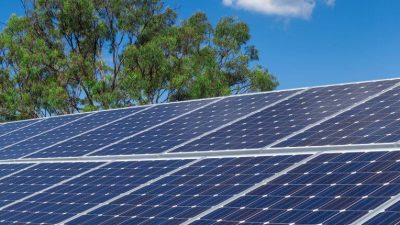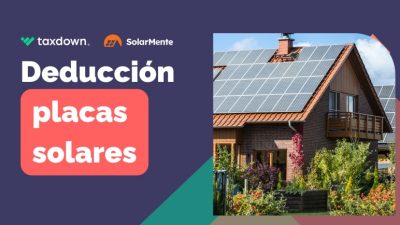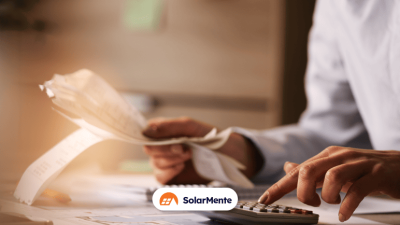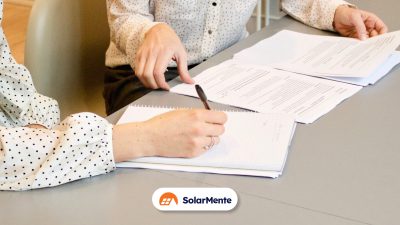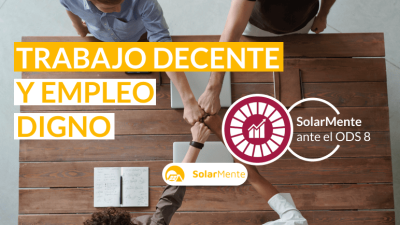In this post, we will guide you through everything you need to know to benefit from the IBI rebate for the installation of solar panels, from understanding what exactly the IBI is to how you can correctly apply for the rebate in your locality.
With this information, you will be one step closer to making your personal contribution to sustainability and, at the same time, gain significant tax benefits.
What is IBI and how does it affect solar panel owners?
Real Estate Tax (IBI) is one of the most significant taxes affecting property owners in Spain.
IBI stands for Impuesto sobre Bienes Inmuebles, i.e. on land, buildings and other elements within them. They must be registered in the Cadastre in order to quantify all the real estate in the territory and to be able to classify them by shape, size, use and value.
IBI is a tax that aims at an equitable distribution of wealth. Each owner of a property or premises contributes a certain amount of money – but not in order to receive a benefit such as rights or a reduction in other taxes – but so that the local councils can continue to finance them.
Therefore, although it is a municipal tax established by state regulations, it is ultimately collected by the local councils, which is why in each place both the percentages of the rebate and the years that the rebate can last can vary.
How is IBI calculated?
This municipal tax is calculated on the basis of the cadastral value of the property and varies according to the tax rate that each municipality decides to apply. Generally, the tax rate is between 0.4% and 1.3% of the cadastral value, which can represent a considerable sum each year.
Although not straightforward, it is calculated like any other tax, taking into consideration several elements:
- ✔️Base IBI Taxable: this is the starting point of the tax, the cadastral value of the property is taken as a reference.
- ✔️Base liquidable IBI: this is when the corresponding reductions are applied to the previously calculated taxable base. In addition, each local council decides the times and percentages of the reductions, for example, for having solar panels installed.
- ✔️Cuota: once we have the taxable base, knowing the tax applied by the Town Hall, which by law is between 0.4% and 1.3% in urban properties and 0.3% and 0.9% in rustic properties, we will know the total tax liability. It should be borne in mind that, depending on the purposes of each municipality, this may vary each year.
- ✔️Cuota liquid: this is the final result. It is obtained by applying the allowances to the full tax liability. These can be national or local.
IBI and photovoltaic installations
For homeowners who decide to install solar PV systems, the IBI can have a less onerous impact thanks to the available rebates. These rebates are an initiative by municipalities to promote the adoption of renewable energy and improve the energy efficiency of homes and businesses.
The IBI rebate for PV installations can vary significantly between municipalities, but commonly offers a reduction of up to 50% of the annual tax, depending on local policies.
Benefits of the IBI rebate
The main advantage of this rebate is the direct financial savings in annual property costs. For a property owner, this means that investing in solar energy not only reduces month-to-month electricity costs but also lowers the annual tax burden.
In addition, this rebate can considerably improve the payback time of the investment in solar systems, making the decision to switch to PV self-consumption even more attractive.
Variability between municipalities
It is important to note that not all municipalities offer these reductions and that the conditions and the percentage of reduction can change not only from one region to another but even between neighbouring municipalities.
Some city councils, such as those of Seville and Ceuta, have been particularly generous, offering bonuses that can extend up to 30 years.
In summary, the IBI rebate for solar installations not only facilitates the transition to a more sustainable energy model but also offers tangible tax relief for homeowners. However, due to the diversity of criteria and processes between municipalities, it is crucial to be well informed and understand the specific requirements in your locality in order to maximise this benefit.
Steps to apply for IBI tax relief
Applying for the IBI rebate for the installation of solar panels may seem like a complicated process, but with the right information and proper preparation, you can navigate the procedure with ease. Here are the general steps to follow to ensure you can take advantage of this tax saving opportunity.
Step 1: Check bonus availability
Before starting any procedures, it is essential to confirm whether your municipality offers subsidies for the installation of photovoltaic systems. This information is usually available on the municipality’s website or can be obtained by contacting the citizen service office directly. Check not only the availability but also the percentage of the rebate and the duration of the rebate.
Step 2: Fulfilling the necessary requirements
Each municipality may set specific requirements that applicants must meet in order to qualify for the bonus. Commonly, these requirements include:
- Have a solar panel system installed on the property.
- Be up to date with all municipal tax payments.
- Have the documentation that accredits the installation and operation of the photovoltaic system.
It is important to carefully review these requirements and ensure that you meet each of them before proceeding.
Step 3: Gather the necessary documentation
Depending on your municipality, the required documentation may vary. However, it is generally requested:
- Certificate of installation of the solar panels (CIE).
- Invoice of purchase and installation of the system.
- Receipt of the last payment of IBI.
- DNI of the applicant
- Documentation proving that you are up to date with other local taxes and fees.
Step 4: Submit the application
Once you have all the documentation and have confirmed that you meet the requirements, the next step is to submit the application. This can be done in a number of ways, depending on the facilities offered by your local council:
- Electronically: Many local councils allow this procedure to be carried out online via their website.
- In person: Some require the application to be made in person at the municipal offices.
Step 5: Wait for the response
After you submit your application, the municipality will review the documentation and decide whether you meet the criteria for the subsidy. This process can take anywhere from a few weeks to several months, depending on the locality. You will receive a notification with the decision, either by email, post or through a notification on the municipality’s online portal.
Additional advice
- Make sure you apply for the rebate within the deadline set by your local council.
- Keep copies of all documentation and communications in case you need to follow up or appeal a decision.
Applying for the IBI rebate for the installation of solar panels is an excellent way to reduce your annual operating costs and support sustainability. Although the process may vary from municipality to municipality, the basic steps are generally the same.
Practical examples and case studies
To illustrate how the IBI rebate application process can work in practice and the benefits that can be obtained, let us explore some examples and case studies.
These examples highlight the real-life experiences of homeowners who have navigated the application process and are now enjoying the economic benefits of their solar energy systems.
Case Study 1: Family in Seville
Initial situation:
A family in Seville installed solar panels on their detached house in 2020. They decided to investigate the possibilities for tax savings and discovered that the city council offered a 50% rebate on IBI for photovoltaic installations.
Application process:
The family made sure they were up to date with all their municipal taxes and gathered the necessary documentation, including the installation certificate and invoices. They submitted their application electronically through the municipality’s portal and received confirmation of receipt the same day.
Result:
After a two-month review period, the council approved their application. Since then, they have enjoyed a 50% reduction in their IBI for 3 years and will enjoy a 30% reduction over the next 27 years, which has contributed significantly to amortising the initial investment in the solar panels.
Case Study 2: Small business in Barcelona
Initial situation:
A small company in Barcelona, dedicated to the technology sector, decided to install a photovoltaic system on its office building in 2019 to reduce its operating costs and environmental impact.
Application process:
The company’s manager checked the IBI rebate requirements of the Barcelona City Council, which included being registered in the Economic Activities Tax (IAE). They gathered the necessary documentation and decided to apply in person at the municipal office.
Result:
The application was approved within three months. The company received a 40% IBI rebate for 5 years. This saving has allowed them to reinvest in other areas of their business, thus promoting growth and sustainability.
Case Study 3: Multiple homeowner in Fuenlabrada (Madrid)
Initial situation:
A landlord of several rental properties in Fuenlabrada (Madrid) installed photovoltaic systems on all his properties in 2018, seeking to attract tenants interested in sustainable housing and reduce the energy bill of the properties.
Application process:
After verifying that the municipality of Fuenlabrada offered an IBI rebate for properties with photovoltaic installations, the owner submitted the corresponding applications for each property, using the assistance of a tax advisor to ensure that the documentation was complete and correct.
Result:
All applications were approved, and the owner now enjoys a 50% rebate on the IBI of each property for the next 3 years. This has not only improved the profitability of their property investments but also increased the attractiveness of their properties on the rental market.
Frequently asked questions about IBI
To complement the guide on how to apply for the IBI rebate for the installation of solar panels, we have compiled some of the most common questions that homeowners often have.
Can I apply for the IBI rebate if I already have solar panels installed?
Yes, you can apply for the bonus as long as your municipality offers this benefit and you meet the specified requirements. Pre-installation does not automatically exclude you, but you must make sure that all documents and permits are in order.
What happens if I change my address after I have received the bonus?
The IBI rebate is linked to the property where the solar panels are installed, not to the owner. If you sell or move house, the rebate remains with the property, benefiting the new owner.
How can I find out if my municipality offers IBI rebates for photovoltaic installations?
The best way to obtain this information is to visit your local council’s website or contact your local council’s citizens’ advice bureau directly. You can also contact us.
Does the IBI rebate affect other taxes or subsidies?
Generally, the IBI rebate is independent of other subsidies or tax benefits you may be receiving. However, it is advisable to consult a tax advisor to fully understand the tax impact of your solar installations.
Are you ready to reduce your energy bill and take advantage of IBI rebates? Contact us today and switch to a solar subscription.






